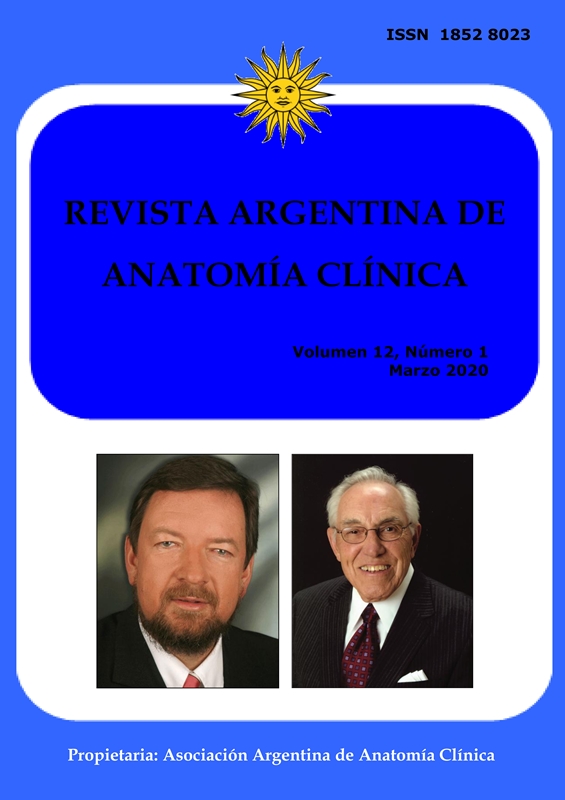Azigos lobe: A cadaveric case report
Español
DOI:
https://doi.org/10.31051/1852.8023.v12.n1.26711Keywords:
azygos vein; azygos arch; azygos system.Abstract
Introduction: the azygos vein gives its name to a complex vascular system, located in the mediastinum, composing a blood route parallel to the inferior vena cava. This is why it represents an alternative route to venous drainage of the inferior vena cava territory in certain pathologies. The vein ends on the superior vena cava, at the level of the fourth thoracic vertebra, after performing a staff from the posterior mediastinum to the anterior, in intimate relationship with the inner face of the right lung. Material and Method: A cadaveric case of a malformation in the pathway of the azygos vein is reported in an adult cadaver previously fixed in solution based on formaldehyde. The dissection was carried out in the Anatomy Department during a routine dissection in the chest region. Results: it was found that the azygos vein arch had an intraparenchymal path in the right lung, generating a separation of the parenchyma from the pulmonary vertex to the vein. The arch was found at its usual vertebral level and it opened as described in the literature. Discussion: The lobe of the azygos vein is a congenital malformation caused by an alteration in the embryonic development of the azygos vein which, on its descent into the thorax, drags a portion of visceral pleura and penetrates the right upper lobe generating an anomalous fissure and therefore delimiting an accessory lobe. According to most of the authors, it is a rather frequent malformation, representing 0.4% of chest radiographs. Conclusion: A cadaveric case with the existence of the azygous lobe is reported, contributing one more tool to the anatomical and imaging scientific discussion.
References
Anson BJ, McVay CB. 1984. Surgical anatomy. 60th edición, Tokyo, Japón: W.B. Saunders Co, pag 464–65.
Betschart T, Goerres GW. 2009. Azygos lobe without azygos vein as a sign of previous iatrogenic pneumothorax: two case reports. SurgRadiolAnat 31: 559–62.
Borrego Rodríguez B, Gorrín Torres V, Ramírez Velozo D, Palacios Hernández TL, Castillo Bandomo RV. 2007. Lóbulo ácigos. Presentación de un caso en pediatría. Gacmédespirit 9 (3): 4-5.
Dudiak CM, Olson MC, Posniak HV. 1991. CT Evaluation of Congenital andAcquired Abnormalities of the Azygos System. RadioGraphics 11: 233-46.
EstapéCarriquiry G. 1986. Mediastino, Anatomía: mediastino y papila duodenal. 1° edición, Montevideo: Editorial Oficina del libro FEFMUR, pag 28-29.
Kutoglu T, Turut M, Kocabiyik N, Ozan H, Yildirim M. 2012. Anatomical analysis of azygos vein system in human cadavers. Rom J Morphol Embryol 53(4): 1051–56.
LoCicero J, Feins RH, Colson YL, Rocco G. 2018. Shields' General Thoracic Surgery.Volumen 1. 8° Edición, Estados Unidos: WoltersKluwer, pag 164-65.
Mata J, Caceres J, Alegret X, Coscojuela P, de Marcos JA. 1991. Imaging of the ázygos lobe: normal anatomy and variations. AJR 156: 931-37.
MooreLK. 2009. Aparato cardiovascular, Embriología clínica. 7° edición, Barcelona: Editorial Elsevier, pag 286-88.
Piciucchi S, Barone D, Sanna S, Dubini A, Goodman LR, Oboldi D, Bertocco M, Ciccotosto C, Gavelli G, Carloni A, Poletti V. 2014. The azygos vein pathway: an overview from anatomical variations to pathological changes. InsightsImaging 5: 619–28.
Rouviere H, Delmas A. 1987. Tomo segundo: Tronco, Anatomía humana.Descriptiva, topográfica y funcional. 9° edición, Barcelona: Editorial Masson SA, pag 235-38.
Sadikot RT, Cowen ME, Arnold AG. 1997. Spontaneous pneumothorax in apatient with an azygos lobe. Thorax 52: 579–80.
Speckman JM, Gamsu G, Webb WR. 1981. Alterations in CT mediastinalanatomy produced by an azygos lobe. AJR 137: 47-50.
Downloads
Published
Issue
Section
License
Authors retain copyright and grant the journal right of first publication with the work simultaneously licensed under a Creative Commons Attribution License that allows others to share the work with an acknowledgement of the work's authorship and initial publication in this journal. Use restricted to non commercial purposes.
Once the manuscript has been accepted for publications, authors will sign a Copyright Transfer Agreement to let the “Asociación Argentina de Anatomía Clínica” (Argentine Association of Clinical Anatomy) to edit, publish and disseminate the contribution.



